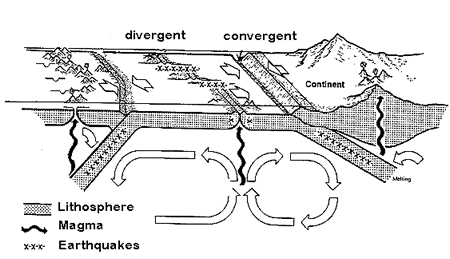BACKGROUND:
Volcanoes are mountains which are built by
accumulation of their own eruptive products including lava, fragments of
former rocks, bombs, and ash. Driven by buoyancy and gas pressure, molten
rock, which is lighter than the surrounding solid rock, moves upward and
breaks through a weak zone in the Earth's crust. The magma erupts and builds
the volcano. Most volcanoes form at convergent or divergent plate
boundaries, where much magma is generated.
 The
parts of a volcano include a reservoir of magma inside the Earth, often called
a magma chamber. The magma chamber is connected to the surface of the Earth by
a vent. It breaks through the surface of the Earth at the volcano’s crater,
and may flow down its side as a flow of lava. Note that magma generally does
not form in the magma chamber; it is generated deeper in the Earth, and
ascends and collects there.
The
parts of a volcano include a reservoir of magma inside the Earth, often called
a magma chamber. The magma chamber is connected to the surface of the Earth by
a vent. It breaks through the surface of the Earth at the volcano’s crater,
and may flow down its side as a flow of lava. Note that magma generally does
not form in the magma chamber; it is generated deeper in the Earth, and
ascends and collects there.
The growth of a volcano is sometimes
difficult for students to conceptualize. The volcano builds upward as more and
more lava and ash are erupted. You may wish to explain this as "growing
from the inside out". In this exercise, students will learn about the
formation of a volcano by building a clay model.
There are different ways to classify
volcanoes. In this exercise students are asked to look at cinder cones,
composite volcanoes, and shield volcanoes. Cinder cones are simple types of
volcanoes. They are usually built by gas-charged lava that breaks into small
fragments (or cinders) as it erupts. This material piles up around the
volcano, building a cone-like structure. Most cinder cones have a bowl shaped
crater at the summit, and are usually smaller volcanoes (less than 350 meters
high). Paricutin is a famous cinder cone that erupted in 1943 in a corn field
in Mexico. Over a period of 6 years, it destroyed the surrounding area.
Composite volcanos are also referred to as
stratovolcanoes. They are usually steep-sided, symmetrical cones of very large
dimensions. They are built of alternating layers of ash, cinders, blocks, and
bombs. Mount Fuji in Japan, Mount Shasta in California, and Mount St. Helens
in Washington are all composite volcanoes.
Shield volcanoes are built almost entirely
of lava flows. Flow after flow comes from the crater and fissures along the
flank of the volcano which constantly build up the shield. The Hawaiian
volcanoes are examples of shield volcanoes.
The growth of a volcano is sometimes
difficult for students to conceptualize. The volcano builds upward as more and
more lava and ash are erupted. You may wish to explain this as "growing
from the inside out". In this exercise, students will learn about the
formation of a volcano by building a clay model.
PROCEDURE:
- Ask your students "What is a volcano". Write their answers
on the board. Explain that volcanoes are mountain-like structures that
emit volcanic lava or other types of volcanic rocks, either in the past
or present. Emphasize that not all mountains are volcanoes. Some
mountains are pushed upward when plates collide at a convergent plate
boundary, or when plates slip by each other at a transform plate
boundary.
- Ask your students to compile a classroom list of what comes out of
volcanoes (lava, ash, steam, gases). Go over the 3 different types of
volcanoes using the diagrams on the lab sheet. An image of this to
project is on a following page.
- Divide the students into pairs. Assign each pair one of the three
different types of volcanoes. Have them make a clay model of their type
of volcano. They should include the a magma chamber, vent, and crater.
Emphasize to the students that they are to model the volcano as if it is
erupting. New lava or magma should be a different color from old lava.
Make sure that the students build the volcano as if it had repeatedly
" erupted", layer by layer from the bottom up. If they do this
exercise right, it will take them some time to "layer" the
different parts of the volcano. Remember that a magma chamber would be
roughly spherical in three dimensions.
- After they finish building the model, have them cut it in half, to see
a cross section. Each student thus gets a half to take home (if there is
sufficient clay). A good way to cut the clay is by using a strong string
and dragging it in a downward motion through the model.
- If the students modeled their volcanoes correctly, the cross sections
should resemble the diagrams on the lab sheet. Have the students look at
another group's work, so that students view a composite, shield, and
cinder volcanoes. Have them complete the lab sheet.